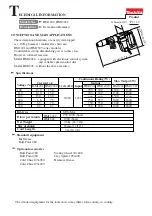
3–600 Page 3
For these smaller loads the lifting devices should be
fastened to the lifting attachments normally built into
the individual motor, engine, pump or transmission/
torque converter, or their separate support skids.
When lifting subassembled components, for example
a suction stabilizer attached to suction piping or a dis-
charge pulsation dampener attached to a strainer cross
and piping, use special lifting slings designed to safely
support the combined weight of the components.
If a crane or hoist is being used to lift large components
or assemblies, one or more persons should assist the
operator from the ground with guide lines attached to
the equipment being moved to properly position it and
prevent uncontrolled movement.
When you start to lift a pump, package unit, subassem-
blies or individual components and you observe the
equipment is tilting, or appears unbalanced, lower the
equipment and adjust the lifting device to eliminate
these improper lifting conditions before proceeding to
move the equipment.
It is poor practice and dangerous to allow the equip-
ment to pass over or close to your body or limbs. Be
prepared to move quickly out of danger if equipment
starts to fall, slip or move unexpectedly toward you.
PRESSURIZED PUMP SYSTEMS
Fluids under high pressure can pos-
sess sufficient energy to cause per-
sonal injury, death and/or equipment
damage either through direct contact
with escaping fluid streams or by con-
tact with loose objects the pressur-
ized fluid propels.
Operating a pump against a blocked or restricted dis-
charge line can produce excessive pressures in the en-
tire discharge system, which can damage or burst dis-
charge system components.
Never operate a pump without a prop-
erly sized pressure relief valve lo-
cated in the flowing discharge line im-
mediately adjacent to the pump dis-
charge connection.
The relief valve should be placed in the flowing dis-
charge line and not at the opposite end of the discharge
manifold in a dead end connection. The dead end may
become clogged with solid material carried in the fluid,
which could prevent proper relief valve operation.
Never place a shut–off valve or any
other component between the pump
discharge connection and the pres-
sure relief valve.
Make sure the pressure relief valve is installed so any
pressurized relief discharge from the valve is directed
away from possible contact with people or equipment.
The relief valve must be set to relieve at a pressure
equal to or below the maximum pressure values shown
on the pump data plate. However, if a component is
used in the discharge system with a lower rated pres-
sure capability than that listed on the pump data plate,
the pressure relief valve must be set to relieve at a pres-
sure equal to or below the rated capability of the lowest
rated component.
Before starting the pump every time, check to in-
sure:
S
The pressure relief valve is in good operating
condition and has been set to the proper relief
pressure.
S
Any pipe line used to direct pressurized relief
flow to another location, such as a collecting
tank, is not blocked.
S
The discharge system is not blocked and all the
discharge line valves are open.
Check all fluid end discharge system components
including pipe, connections, elbows, threads, fas-
teners, hoses, etc., at least once every six months
to confirm their structural adequacy. With time,
wear, corrosion and fatigue can reduce the strength of
all components. Magnetic iron and steel components
should be checked with magnetic particle or dye pene-
trant crack detection equipment. Nonmagnetic materi-
als should be checked for cracks with dye penetrants.
All metallic components should also be visually
checked during these inspections for signs of corro-
sion. If a component shows evidence of cracking or
loss of material due to corrosion it must be replaced
with a new part.
Continually monitor suction and discharge hose as-
semblies when the pump is operating for leakage, kink-
ing, abrasion, corrosion or any other signs of wear or
damage.









































